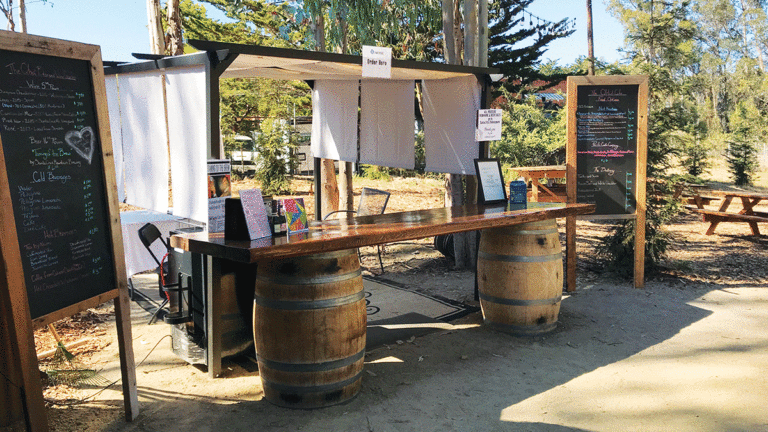This area’s most anticipated restaurant opening of the year is about to launch in Santa Cruz County.
Aptos Village is the home of chef David Kinch’s latest culinary adventure, Mentone (pronounced “men-tawn-eh.”). The chef and creator of three-star Michelin restaurant Manresa, Kinch has lived in Santa Cruz for the past 22 years. And while his heart belongs to the Central Coast, right now his mind is fixated on the French/Italian Riviera and the town of Menton, where Mirazur has just captured its third Michelin star.
It’s one of Kinch’s favorite dining spots, so to celebrate the honor, he’ll join Mirazur chef Mauro Colagreco for some culinary creativity. “We’ll be cooking on the beach for 120 lucky people,” Kinch says with a grin.
So smitten is Kinch with this stretch of cinematic Riviera that he has named his new Aptos restaurant after Menton. “It’s the Italian version of the French town’s name,” he explains. This region was part of the Republic of Genoa right up until 1860, when it became part of France. Hence the co-mingled cuisines from Italy and the south of France at the new restaurant—Mediterranean coastal cuisine spun through Kinch’s own California vision.
The Inspiration
“It reminds me of our stretch of coastline,” Kinch says of the azure European coast discovered while visiting friends on culinary visits and cooking odysseys. Anyone who’s visited the South of France, or the Ligurian coast between Nice and Genoa, can understand exactly why he would be taken by the bold, sun-drenched flavors of the region.
After all, this is the place that gave us focaccia, salame and pesto. Far from the concept-intensive world of Manresa, this Kinch eatery will be casual enough to highlight pizza—fueled by Kinch’s inventiveness and the freshly milled flour from Manresa Bread, the bakery branch of Manresa powered by superstar baker Avery Ruzicka.
The Place
Why Aptos? “My business partner Andrew Burnham found this opportunity,” Kinch says. “And he urged me to buy the building.” The chef has been steadily building his brand since he opened Manresa in Los Gatos in 2002, and the restaurant earned its first two Michelin stars in 2007 (it was upgraded to three in 2016). Kinch had been looking for a new restaurant space in downtown Santa Cruz for a few years. Bywater, the more casual, New Orleans-inspired restaurant he opened in 2016, is also located in Los Gatos.
“I wanted to be on this side of the hill,” Kinch says. “I like expanding our reach. I think we can fill a need.”
He also looks forward to a minimal commute. “Right now, I’m waiting to build—just waiting for the final signing,” Kinch says. “We spent most of last year working on this. They’ve built the shell. It just needs finishing inside.” The food entrepreneur says the end result “will evoke the area we were inspired by, as well as our own Central Coast.”
The Setup
Yes, there will be a full bar, “with a lot of amaros and Italian wines,” he says. The chef at Mentone will be Matt Bowden, currently Executive Sous Chef at Manresa. “If I’m in town, I’ll be in the kitchen, too,” says Kinch, happy finessing the pizzas. “We’re going to be doing five pies using a Mugnaini wood-fired oven. We have our own mill, and can now mill our own grains.” The flavor and freshness, he contends, cannot be rivaled. “I’m developing pastas—we’ll make lots of pastas,” he says. “It’s going to be simple. It’s going to be food inspired by the region.” Authentic, yes, “but with my own spin.”
“We’re having a lot of fun working on this,” he says. “Andrew Burnham is a great business partner. He’s my partner at the bakery, and with the restaurants. Andrew’s business expertise allows me to work the food side.”
The Menu
Kinch’s concepts can be subtle, and tend to defy categorization. But the seasons and the geographical setting are invariably folded into his menus. He shows me a glamorous shot of actors Catherine Deneuve and Marcello Mastroianni at the height of their cinematic fame and beauty. “That’s on our brand,” he says with obvious pleasure. Two film stars, one French, one Italian. That’s the sizzle Kinch wants for Mentone, accessible and appealing.
There will be pesto, farinata, ratatouille, pizza, and, “We’re developing our own focaccia,” Kinch says.
The new spot will be kid-friendly, headds, “like a trattoria.” Dinner-only at first, six nights a week, with perhaps a brunch on Saturday and Sunday. “We’ll have take out,” he promises.
Kinch fans can look forward to “a lot of custom salames, like culatello, coppa,” specialty charcuterie that will be made for Kinch in the Bay Area. “And a wine list that harmonizes with the food. It’ll be a short wine list, 30 reds and 30 whites, Provencal and Ligurian wines. Some Sicilian whites, Dolcetto d’Alba, a Cotes Ventoux, and of course Bandol.” Cioppino? “Definitely. But Central Coast style,” he says. “We’ll make it with Dungeness crab and abalone from Monterey.”
Kinch is elbow-deep in tinkering and experimenting with pastas for the Mentone menu. “I’ve perfected cacio et pepe,” he says with an impish grin. “And I’m working on pesto. Pesto is one of the greatest sauces.”
Kinch wants the best and freshest produce from local growers for Mentone. “We’re working with several organic growers now,” says the chef, who famously had biodynamic specialties grown exclusively for his restaurant. He’s especially excited about using custom-grown Genovese basil. The magic chemistry of garlic, olive oil, pine nuts, Parmigiano-Reggiano, and basil is one of Italy’s greatest gifts to cuisine. “Our trenette al pesto [made with three different varieties of basil] will have a California spin,” says Kinch. And then he reveals the secret California ingredient in his pesto, which I will not divulge.
The Star
Anthony Bourdain once described Kinch’s cooking as “wildly creative … beautifully presented and surprisingly minimalist—very, very tasty.” Kinch keeps living up to that assessment.
After learning everything he could in top kitchens in New York, San Francisco and Europe, Kinch opened a small, Catalan-inspired dining room in Saratoga in 1995 called Sent Sovi, which is where I first tasted his cooking. Then came Manresa, where the Michelin stars began to accumulate, as did international culinary guest chef gigs and James Beard awards, including Best Chef: Pacific in 2010. Born in Philadelphia and raised in Louisiana, Kinch opened Bywater as a spicy love letter to the Cajun and Creole foods of his New Orleans roots. But now his imagination has zeroed in on the Mediterranean climate of his current home.
Fit and tanned, drinking iced green tea at the Delmarette, Kinch has just returned from two weeks of cooking and eating in Toulouse, Marseilles, Genoa, and the Dolomites. “I’m doing less and less guest chef gigs,” he insists, suddenly looking reflective. “I’m getting near the end of expansion, and I don’t know what I might do next. There’s still a lot of French bistro cooking I’d like to do. But I tend to take baby steps,” he admits. “I like to get everything lined up and worked out in advance.”
There are a lot of reasons Kinch enjoys living here. “It’s close to the ocean, it’s got the university and all the activity that goes with that,” he says. “I’ve lived in Manhattan and in San Francisco. I don’t want a big city anymore. I need a separation between my personal and professional life.”
Food is the focus of his life, and it always was. “I fell into that rabbit hole early on, and pretty hard. I’m always curious. And I’m not afraid to learn.”
But Kinch says he needs to recharge a few times a year. “Especially as I get older,” says the 58-year-old chef. “For me, it’s always a beach. I relax, surf, sleep a lot, have a rum drink at two in the afternoon. It helps to reorganize my priorities. I try to do that twice a year.”
His favorite thing to do is having great restaurant meal. “Fine dining—that’s where the ideas are,” he says. What he loves is not so much particular dishes, but “experiencing the whole place, the chef’s vision.”
Kinch says he tries not to travel during the summers so he can stay home in Santa Cruz. “I’ve got the beach, I cook at home. Simple picnic foods—pastas, tomato salads, roast chicken, very simple.” But right now, he’s not exactly kicking back. In addition to overseeing the finishing touches on Mentone, he’s just signed a second cookbook deal and currently spends the mornings working on recipes. “The manuscript is due in November, and then photography for the cookbook will start.” He suddenly remembers, “I’ve got a busy travel schedule in November.”
On that note, Kinch zooms off on his powder blue Vespa looking every inch the seaside—Santa Cruz—Italian.
Mentone
Location: Aptos Village
Size: 3,000 sq. feet; seating for 100
Chef de Cuisine: Matt Bowden, executive sous chef at Manresa
Special features: Full bar; Italian and California wines; Mugnaini wood-fired pizza oven
Cuisine: French/Italian/Coastal California—pasta, pizza, cioppino, focaccia, custom salames
Ambience: Casual; family friendly
Opening date: Late summer/early fall 2019
Other David Kinch projects: Look for the upcoming Mineta San Jose Airport installation of California Market by David Kinch—a dining, bakery, coffee and bar experience curated and designed by the James Beard Award-winning chef.
Update: This story previously misstated the birthplace of David Kinch and misspelled the name of Avery Ruzicka.
























